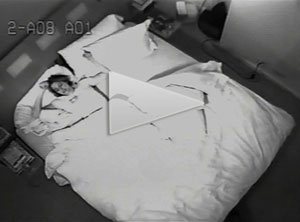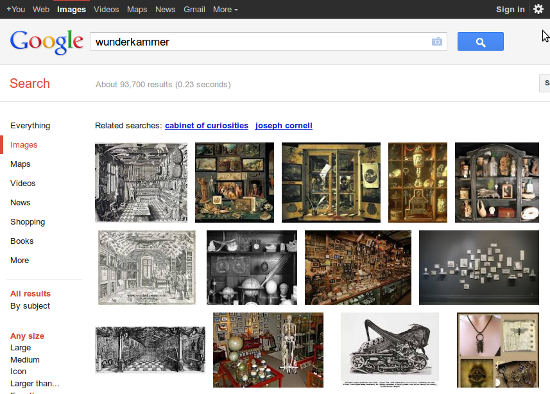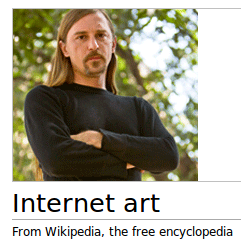User:Sebastians
 Wiki War will be back
Wiki War will be back
Thank you Andre: Father Christmas
Google Search by Image
Performing a search on Google is a bit like looking at a Wunderkammer (cabinet of curiosities). Of course, this comparison is not really apt as the search results mostly aren't curiosities (in fact, they should be way more often!). However, the search results page is an assemblage of things found in a space, that has expanded to such a degree, that we can't make any sense of it anymore without the help of search engines (which, however, aren't and shouldn't be the only solution to this problem). This space is in fact our externalized collective memory.
By crawling the web, and by analyzing, categorizing, and storing what they find along the way, search engines try to create a paradigm (in the linguistic meaning: a collection of signs) out of which answers to our questions can be constructed. The construction of meaning depends a) on the existence and availability of elements (what we put on the web, and what then gets indexed by the search engine) and b) on the rules applied in order to construct the answer.
It is obvious how the construction of meaning, the formation of knowledge, is shaped by algorithms (rules). However, these algorithms are far from being transparent. In fact they are well kept secrets, often being regarded as a myth. In this sense, the comparison to the Wunderkammer starts to regain some meaning, as Wunder in German not only means curiosity, but also miracle.
It is not only knowledge that equals power, but also the way how knowledge is being shaped. Therefore, algorithms that are not transparent establish and maintain a hierarchy of power.
Google's Search by Image
The decoding of visual signs has long remained a domain of the human being. However, as technology learns to “see”, to decipher visual signs, images become searchable information, too. What really fascinates me at the moment is Google's Search by Image, a feature that allows the user to submit images as “questions”.
How does Google make sense of this immense pile of images, by looking “at” the image, and not at the textual context only? How does the algorithm work, if at all? Is this a useful tool to gain insights into our collective visual memory? Or is it simply a tool empowering media companies and their lawyers, as the search feature makes it in fact very easy to find “illegal” copies of a an image?
Internet Art
Another attempt at creating a database of all things relevant to know is Wikipedia. Instead of relying on algorithms, it is a collaborative effort of people trying to decide what is important enough to be part of the encyclopedia, and then how it best be described.
The entry for http://en.wikipedia.org/wiki/Internet_art is an attempt to textually describe an art form that deals with the Internet, including Wikipedia, as its material.
Through the use of CSS, it is possible to completely replace (overlay) an entry within Wikipedia (as has been proven in the Wiki War). My proposal is to overlay the entry for Internet Art with a "piece of Internet Art" (or a failed attempt), as an experiment to replace the textual description with an example of what it describes. Of course, this version won't last long. The hope is however for it to remain in the entry's history (or will sth. like this be completely deleted?).
Magisto
Equipped with cameras, smartphones, etc, almost everything is being documented (Postman: "to a man with a hammer, everything looks like a nail" – Campanelli: "for an individual with a digital camera, everything seems worth photographing"). And with seemingly unlimited space in the cloud (not our cloud btw), all the generated "documentation" goes online, waiting to be seen, to be rated, to be liked – in general: to generate feedback.
But what if nobody want's to give feedback? With 0 comments, 0 likes, 0 views, things can be really frustrating.
One solution is called Magisto (another might be http://youtube-promos.com/):
"Let's face it, your videos aren't that interesting…"
"Magisto magically turns your long and boring videos into fun, and share-worthy clips……"
"You upload your video and Magisto does the rest…"
{{#ev:youtube|2YL41fGxzvY|500}}
Andy Warhol's Empire is an eight-hour, five-minute film. It shows the Empire State Building from around 8pm till 2:45 am. What one sees is the passing of time, the passage from daylight to darkness. In a way, this, and other films by Warhol, anticipated our "real-time sharing", "life casting" etc.
I fed an excerpt of this film into Magisto as I was interested to see what Magisto's algorithm would make out of it. How it turns a non-film into a "fun, and share-worthy clip":
(Video to come) 
Using another, longer excerpt (1 hour) didn't work out too well. I need to experiment a bit more.

Josh Harris, "the Warhol of the web", invested, earned, and lost a lot of money by experimenting with live and life streaming. He was tried to connect people through video and chat 24/7, thus being able to receive and give feedback at any time.


Quiet: We Live in Public
"an Orwellian, Big Brother concept developed in the late '90s which placed more than 100 artists in a human terrarium under New York City, with myriad webcams following and capturing every move the artists made.[2] The pièce de résistance was a Japanese-style capsule hotel outfitted with cameras in every pod, and screens that allowed each occupant to monitor the other pods[3] installed in the basement by artist Jeff Gompertz"
(Source: http://en.wikipedia.org/wiki/We_Live_In_Public_%282008_film%29)
Everything was for free (living, eating, etc). However, Harris said (more or less): "Everything is for free. However we own all the video tapes."

weliveinpublic.com
"a project that entailed himself and his then girlfriend, Tanya Corrin, living at home under 24 hour internet surveillance viewable by anyone. After a few months Corrin left Harris and the project citing mental and emotional stress. Harris continued "living in public" for a few more weeks, finally ending the site due to the mental, personal, and financial losses the project caused him"
(Source: http://en.wikipedia.org/wiki/Josh_Harris_%28internet%29)
Justin.tv
http://www.justin.tv allows people to stream their webcam to a public audience. Viewers can interact with the lifecasters through a chat that is positioned next to the webcam's video stream. According to the website, it allows people to "Broadcast what you're doing – Go live now, meet new friends and have fun."
It is in fact what Harris did with weliveinpublic.com – only now everybody can do it.
The advantage over vlogging on YouTube is obvious. While the feedback received on YouTube is not a direct one, not something happening in real-time, people on justin.tv can directly communicate with their audience, and vice-versa.
Lifecasters range from "Watching Grandpa" (probably to avoid him hurting himself or dying when alone), to an apparently drunk man and his daughter (maybe 6 or 7 years old), to a teenage girl singing and posing, enjoying the attention and feeling like a soon-to-be Pop Star.


